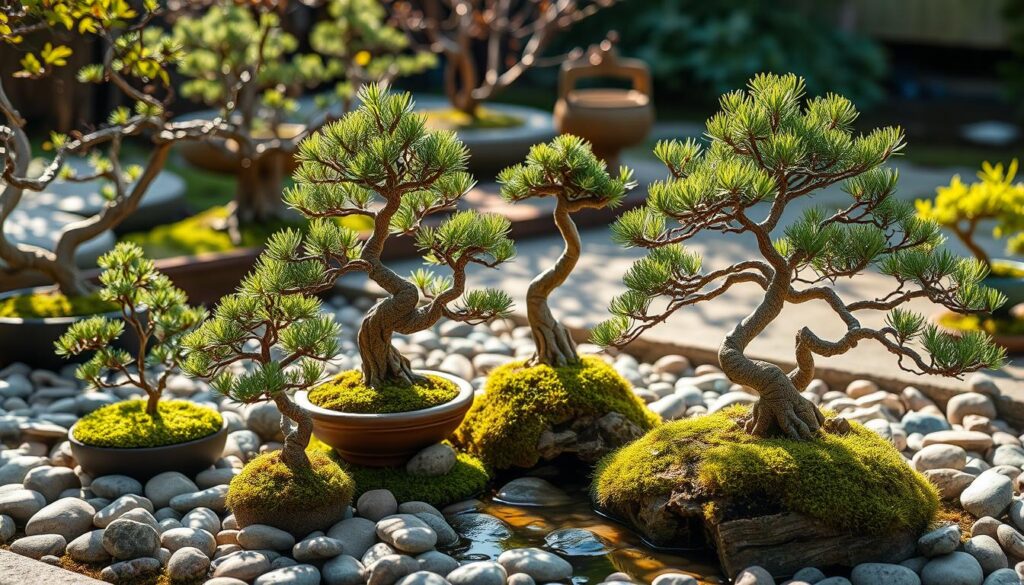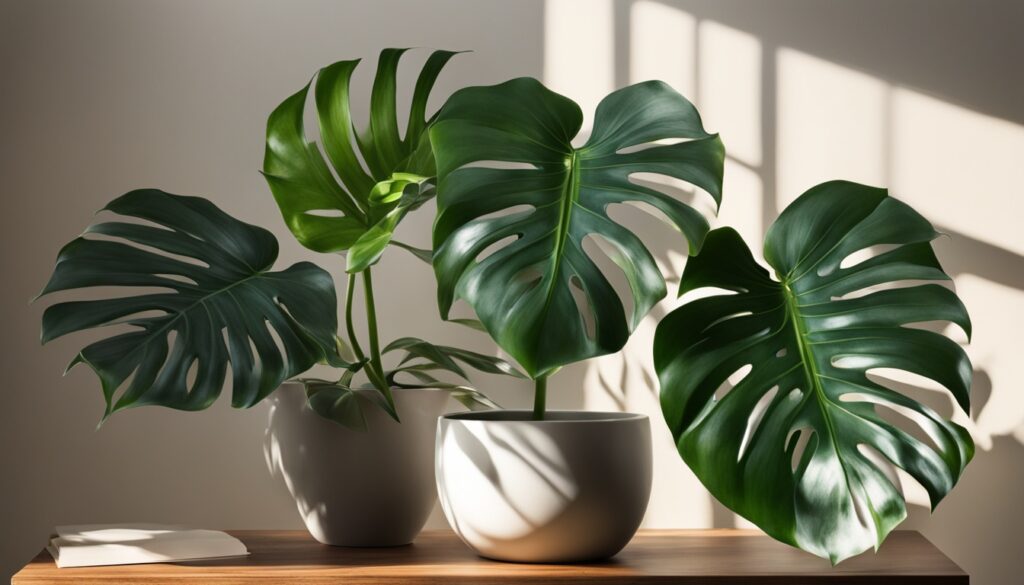In the world of bonsai, knowing how to identify different tree species is key. But is it really important to master bonsai identification? Can beginners unlock the secrets of these tiny wonders, or is it only for experts?
Start your journey of discovery with us. We’ll show you the essential techniques and strategies for identifying bonsai trees. You’ll learn about the basic classifications and how to spot the details in leaves and trunks. This guide will make you a true bonsai expert.
Key Takeaways
- Gain a deeper understanding of the diverse bonsai species and their unique characteristics.
- Explore the importance of scientific names in accurate bonsai identification.
- Discover the essential tools and techniques for recognizing bonsai trees at a glance.
- Uncover the secrets of leaf patterns, trunk formations, and seasonal changes in bonsai identification.
- Dive into the world of popular Japanese maples, elms, conifers, and flowering bonsai varieties.
Understanding the Fundamentals of Bonsai Species
The world of bonsai is full of different plants, each with its own look and growth. These small trees come from many bonsai varieties, like evergreen, deciduous, and coniferous trees. Knowing about the botanical classifications and traits of each species is key for growing bonsai well.
Basic Tree Categories and Classifications
Bonsai trees fall into three main types: broadleaf evergreen, deciduous, and coniferous. Evergreen bonsai, like ficus and gardenia, keep their leaves all year. Deciduous bonsai, such as Japanese maples and elms, lose their leaves with the seasons. Coniferous bonsai, like junipers and pines, have needles and look formal.
Importance of Scientific Names in Identification
Knowing the exact name of a bonsai species is vital for growing and caring for it. Using scientific names helps everyone talk clearly about bonsai. Names like Acer palmatum for Japanese maple or Ulmus parvifolia for Chinese elm make sure we all know what we’re talking about.
Growth Patterns and Characteristics
Every bonsai species has its own way of growing and looking. For example, Japanese maples have unique leaves and colorful fall colors. Chinese elms have fine branches and interesting bark. Knowing these details helps pick the right bonsai and care for it properly.
| Bonsai Species | Leaf Shape | Foliage Type | Growth Habit |
|---|---|---|---|
| Japanese Maple (Acer palmatum) | Hand-shaped | Deciduous | Graceful, compact |
| Chinese Elm (Ulmus parvifolia) | Oval | Deciduous | Fine ramification, textured bark |
| Juniper (Juniperus spp.) | Needle-like | Evergreen | Formal, upright structure |
“Bonsai is the art of growing trees in miniature, a living sculpture crafted through patience, skill, and a deep understanding of the natural world.”
Essential Tools for Bonsai Identification
The art of bonsai identification needs special tools. These tools help you recognize and classify bonsai trees. They include magnifying glasses, reference books, and digital apps. These tools are key to becoming a bonsai expert.
A high-quality magnifying glass is crucial. It lets you see the tiny details of a bonsai tree. Details like leaf shape, bark texture, and growth patterns are important for identifying species.
Reference books and digital apps are also essential. They offer detailed info on bonsai species. This info helps you make accurate identifications.
Knowing the unique features of popular bonsai varieties is helpful. For example, Acer palmatum (Japanese maple) and Ulmus parvifolia (Chinese elm) have distinct features. These features include leaf shape, trunk structure, and branching patterns. They help you identify a bonsai tree quickly and accurately.
| Bonsai Tool | Purpose | Preferred Material |
|---|---|---|
| Magnifying Glass | Examining fine details | High-quality glass |
| Reference Books | Identifying species | Comprehensive, up-to-date |
| Digital Apps | Visual recognition | User-friendly, accurate |
| Bonsai Shears | Pruning and Shaping | High-quality steel |
| Concave Cutters | Branch Cutting | Stainless Steel |
Whether you’re new or experienced in bonsai, learning about these tools is vital. They help you understand the beauty and complexity of bonsai trees.
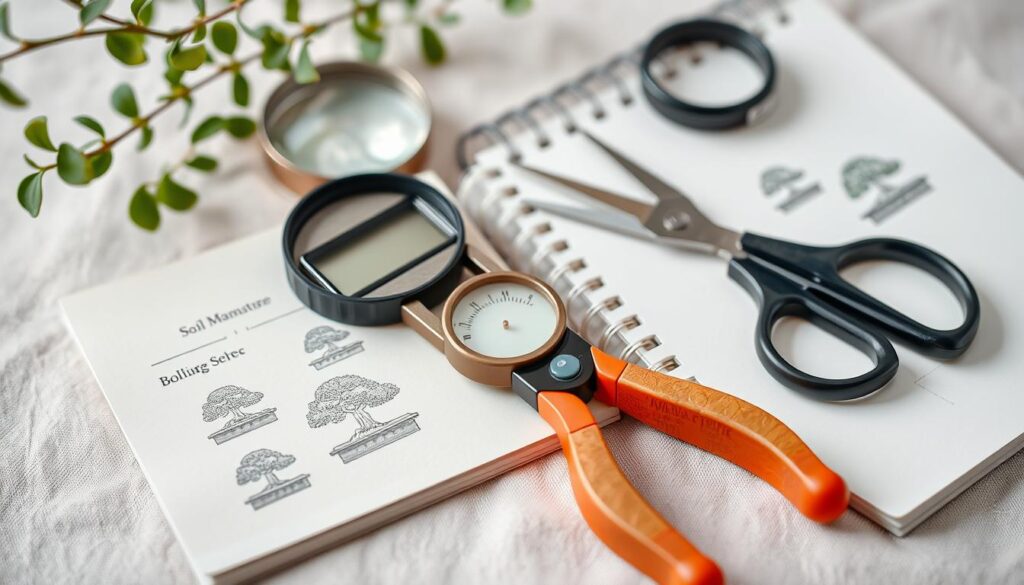
Leaf Patterns and Their Role in Species Recognition
Bonsai lovers know that leaf patterns are key to identifying different species. The unique foliage patterns add to the bonsai aesthetics. They also help us figure out what tree it is.
Deciduous vs. Evergreen Leaf Structures
Deciduous trees, like Japanese maples, have leaves that change with the seasons. They come in many shapes and have detailed edges. Evergreen trees, like junipers, have needles or scales that stay on all year.
Common Leaf Shapes and Arrangements
Bonsai trees have leaves in all shapes, from sharp tips to round ones. The way leaves grow, like opposite or alternate, helps us tell species apart. Knowing these foliage patterns is key to recognizing bonsai species.
Seasonal Changes in Foliage
Deciduous bonsai leaves change a lot with the seasons. Japanese maples turn red or orange in autumn before falling off. Watching these seasonal changes in foliage helps us identify bonsai trees.
“Leaf patterns are the fingerprints of bonsai, revealing the unique identity of each species.”
Trunk Formations and Bark Characteristics
When it comes to tree morphology and bonsai aesthetics, the trunk and bark of a bonsai tree are key. Each bonsai has its own unique trunk and bark. These features add to its beauty and cultural value.
The Zelkova bonsai, a Japanese elm, has delicate branches. It looks graceful and balanced. On the other hand, the Betula pendula, or Silver birch bonsai, has a striking white bark.
The Korean hornbeam (Carpinus turczaninowii) has a knobby trunk. This adds a unique texture to the bonsai.
| Bonsai Variety | Trunk Formation | Bark Characteristics |
|---|---|---|
| Zelkova (Japanese Elm) | Delicate ramification, broom-style | Smooth, gray-brown bark |
| Betula pendula (Silver Birch) | Slender, graceful trunk | Distinctive white, peeling bark |
| Carpinus turczaninowii (Korean Hornbeam) | Knobby, interesting trunk structure | Grayish-brown, ridged bark |
These unique features make bonsais visually appealing. They also help identify different species. For bonsai lovers, understanding these details is essential.
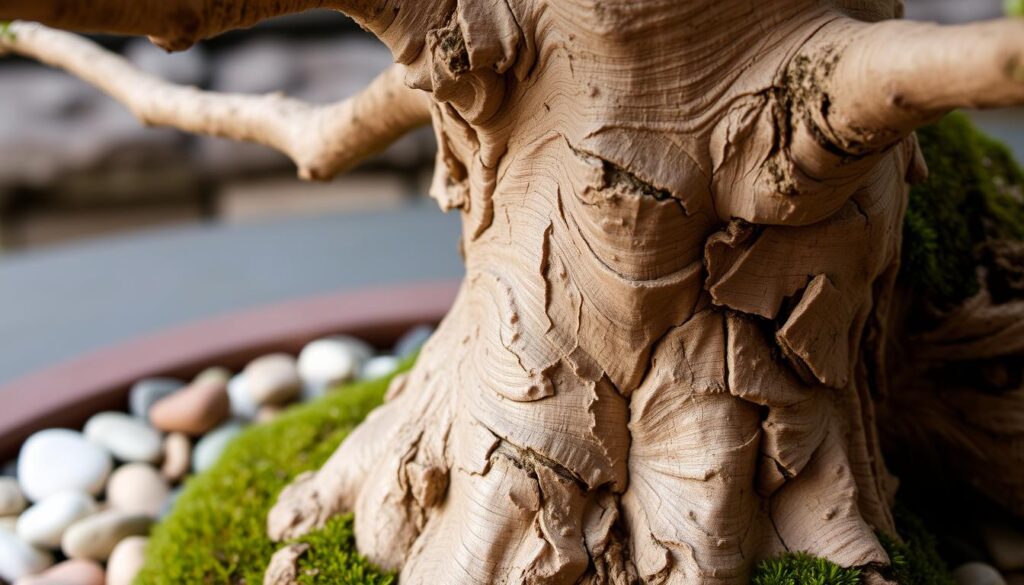
“Bonsai is an art form that requires patience, attention to detail, and a deep appreciation for the natural world.”
Bonsai Identification Through Visual Recognition
Learning to identify bonsai trees is more than just knowing their names. It’s about seeing the unique traits that make each tree special. By improving your visual recognition, you’ll appreciate the bonsai aesthetics even more.
Color and Texture Analysis
The beauty of bonsai lies in its color and texture. From the weathered bark of junipers to the pink blossoms of Japanese cherries, each tree is unique. By looking at the colors, patterns, and textures of leaves, trunks, and branches, you can tell different bonsai species apart.
Growth Habits and Natural Forms
Bonsai trees show their natural beauty in their growth. The shape of a Chinese elm or the dense canopy of a Japanese maple can tell you a lot. Understanding these natural traits helps you see the unique character of each bonsai.
Branch Patterns and Arrangements
The way a bonsai’s branches grow is key to its look. From the fine details of a Wisteria sinensis to the strong lines of a Chinese juniper, branch patterns are distinctive. By studying these patterns, you can learn to recognize different bonsai species.
By combining knowledge of color, texture, growth, and branch patterns, you can improve your visual recognition. With practice, you’ll be able to see the beauty in each bonsai tree.
“The true art of bonsai lies in the ability to see the tree, not just the leaves, branches, and trunk, but the essence of its being.”
– John Naka, renowned bonsai master
Popular Japanese Maple and Elm Varieties
In the world of bonsai, some trees stand out more than others. The Japanese maple (Acer palmatum) is one of them. It’s loved for its changing leaves and wide base with fused roots. There are many types of Japanese maples, each with its own look and challenges.
The Deshojo maple is famous for its bright red leaves that change color with the seasons. The Atropurpureum maple has deep purple leaves and grows slowly. The Kiyohime maple is small and grows sideways, perfect for small pots. But the Arakawa maple’s rough bark is hard to shape into fine details.
The Chinese elm (Ulmus parviflora) is another favorite bonsai tree. It’s known for its fine branches and small leaves. The Zelkova, or Japanese elm, is loved for its delicate, broom-like shape.
| Bonsai Variety | Key Characteristics | Cultivation Considerations |
|---|---|---|
| Acer Palmatum (Japanese Maple) | Distinctive five-pointed leaves, color-changing foliage | Broad nebari, fused roots, various cultivars available |
| Acer Buergerianum (Trident Maple) | Three-pointed leaves, deciduous | Commonly used in oriental bonsai style |
| Ulmus Parviflora (Chinese Elm) | Semi-evergreen, fine ramification, small leaves | Classic oriental bonsai tree, relatively easy care |
| Zelkova (Japanese Elm) | Delicate ramification, broom-style arrangements | Aesthetic appeal and graceful appearance |
The wide range of bonsai varieties and the special horticulture expertise needed to grow them fascinate bonsai lovers everywhere. They offer endless chances for creativity and learning in horticulture.
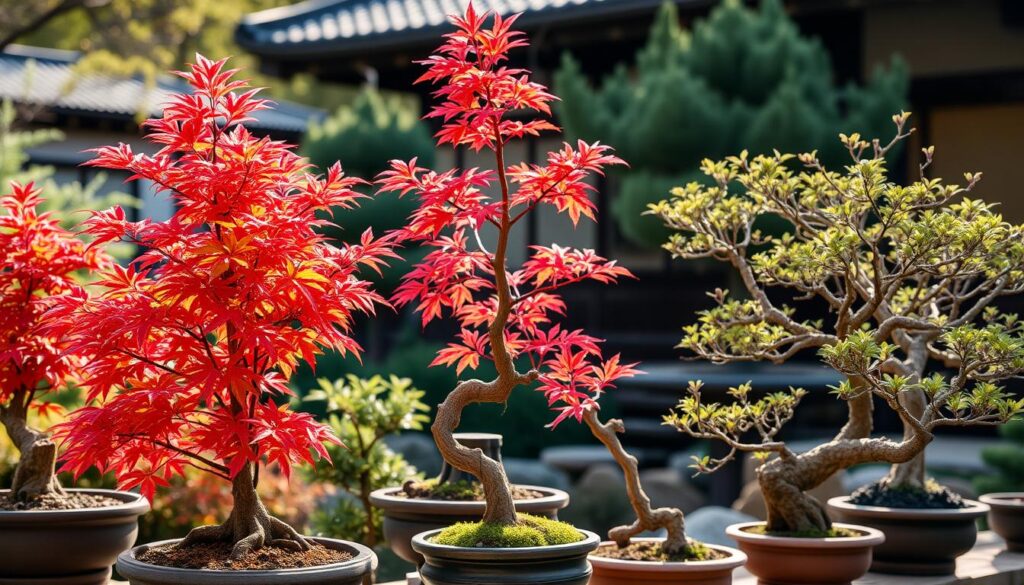
Understanding Coniferous Bonsai Species
Bonsai lovers often get drawn to coniferous bonsai species. These trees have needle-like or scale-like leaves. They include junipers, pines, and spruces. These evergreen trees need special care but are loved for their beauty all year.
Learning about the different coniferous bonsai types can open up new possibilities in bonsai art. Each type has its own look and needs, making them unique.
Needle Types and Arrangements
Coniferous bonsai species have many different needle shapes and arrangements. Junipers have small, scale-like leaves. Pines have longer, more noticeable needles. The shape of the needles helps identify the species and tells us how to care for it.
Common Conifer Varieties
- Juniper bonsai, including Chinese juniper and Japanese shimpaku, are known for being tough and adaptable.
- Pine bonsai trees, like Japanese red and black pines, need special pruning to keep their unique shapes.
- Spruce bonsai, with their dense, sharp needles, add a rugged look to bonsai displays.
- Cypress bonsai, with their small, fern-like leaves that change color in the fall, are valued for their long life and dramatic seasonal changes.
| Bonsai Species | Needle Type | Foliage Characteristics | Care Considerations |
|---|---|---|---|
| Juniper | Scale-like | Delicate, dense foliage | Adapt to a range of conditions, require regular pruning |
| Pine | Longer needles | Distinctive silhouette, seasonal color changes | Specific pruning techniques needed, prefer full sun |
| Spruce | Short, sharp needles | Dense, rugged appearance | Require ample moisture and airflow, vulnerable to pests |
| Cypress | Fern-like, small needles | Vibrant fall colors, long-lived | Thrive in warm, humid conditions, need regular watering |
By learning about the special needs of coniferous bonsai species, bonsai fans can grow these beautiful trees with confidence. They can add depth and variety to their collections.
Flowering Bonsai Identification Guide
The world of bonsai is more than just the shapes and silhouettes. It also includes the beauty of flowering bonsai varieties. These trees are not only visually stunning but also carry deep cultural meaning in many Asian traditions. Let’s look at some key flowering bonsai species and their unique features.
The Prunus mume, or Flowering Apricot, is a favorite. It has delicate white, pink, or red blossoms that smell heavenly. Another favorite is the Chaenomeles japonica ‘Chojubai’, or Japanese Flowering Quince. It’s known for its vibrant red flowers that signal spring’s arrival.
The Magnolia stellata, or Star Magnolia, is also captivating. It has large, fragrant white, pink, or purple flowers. These blooms make the Magnolia a standout in any bonsai collection.
| Bonsai Variety | Flower Color | Symbolic Meaning |
|---|---|---|
| Prunus mume (Flowering Apricot) | White, Pink, Red | Fragrance, Beauty, Renewal |
| Chaenomeles japonica ‘Chojubai’ (Japanese Flowering Quince) | Red | Happiness, Prosperity |
| Magnolia stellata (Star Magnolia) | White, Pink, Purple | Purity, Spiritual Enlightenment |
These are just a few of the flowering bonsai varieties that bonsai lovers cherish. With their vibrant blooms and deep cultural symbolism, these trees add a unique and stunning touch to any bonsai collection.
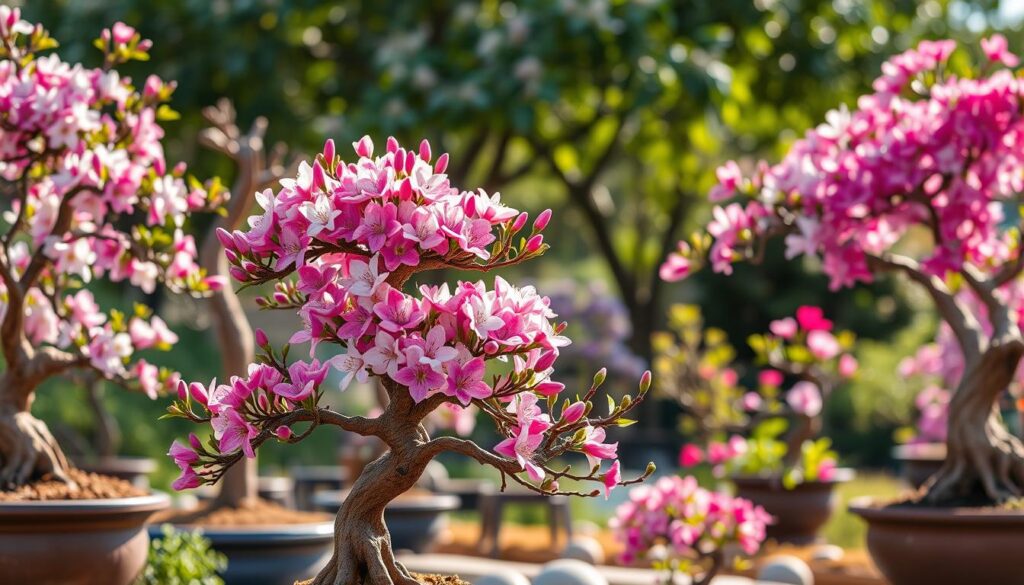
“The art of bonsai is not just about shaping trees, but about capturing the essence of nature and infusing it with profound meaning.”
Root Systems and Their Identifying Features
In the world of bonsai, the root system is key. It affects both looks and how we identify these small trees. The tree morphology and bonsai aesthetics are closely tied to the roots.
Surface Root Patterns
Bonsai is known for its surface roots, or nebari. Species like Ficus have big aerial roots that add to their beauty. The formal upright style (Chokkan) highlights the need for a clear, radial nebari.
Nebari Development Characteristics
- Root pruning and development are key for a good nebari in bonsai.
- Good root care makes the roots look balanced and pretty, matching the tree morphology.
- Regular root pruning and shaping keep the bonsai’s roots healthy and looking good.
| Bonsai Species | Nebari Development | Root Pruning Frequency |
|---|---|---|
| Ficus | Prominent aerial roots | Annually |
| Japanese Maple | Radial, well-defined nebari | Every 2-3 years |
| Pines | Thick, tapered nebari | Every 3-5 years |
Knowing about bonsai root systems helps fans improve their bonsai aesthetics. It also helps them care for these amazing small trees.
“The roots of a bonsai tree are its foundation, shaping the entire plant and contributing to its overall visual appeal. Mastering the art of root management is crucial for the success and longevity of these remarkable miniature wonders.”
Common Mediterranean Bonsai Species
The Mediterranean is full of amazing bonsai species. Each one has its own special charm and can thrive in tough conditions. The Dwarf Pomegranate and the European Olive are two of the most popular.
The Dwarf Pomegranate is a favorite among bonsai lovers. It has bright red flowers and tasty fruit. These trees love warm, dry places and grow well in bonsai form. Their twisted trunks and small size make them very appealing.
The European Olive is another iconic bonsai. It has a unique trunk and leaves that shimmer like silver. These trees are tough and can handle cold temperatures. They are a favorite for their beauty and strength.
| Bonsai Species | Climate Preferences | Propagation Methods | Maintenance Needs |
|---|---|---|---|
| Dwarf Pomegranate (Punica granatum) | Warm, dry climates | Seeds, cuttings | Requires full sun, well-draining soil, and regular pruning |
| European Olive (Olea europaea) | Warm, dry conditions, tolerant of temperatures slightly below freezing | Seeds, cuttings | Needs full sun, well-draining soil, and regular root pruning every 2-3 years |
These Mediterranean bonsai species are not just beautiful but also tough. They are perfect for both new and seasoned bonsai fans. Knowing how to care for them will help you grow these amazing trees.
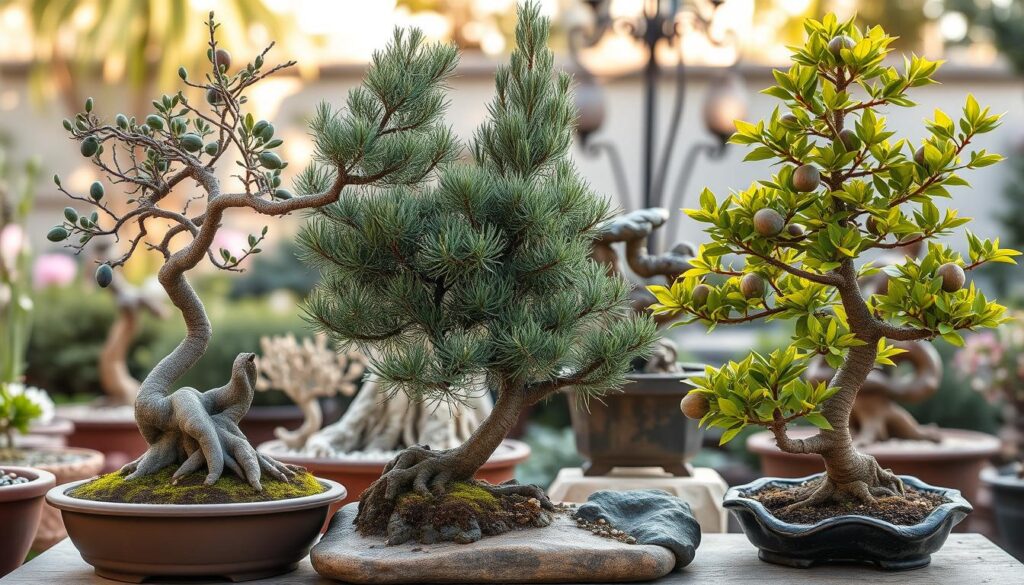
Tropical and Subtropical Bonsai Varieties
For those who love bonsai and want to grow them indoors, tropical and subtropical bonsai are perfect. They include the hardy Ficus and the delicate Carmona. These plants love warm, humid places, making them great for indoor growth.
Indoor Species Identification
The Ficus Bonsai is a top pick for indoor bonsai. Other favorites include Dwarf Jade, Fukien Tea (Carmona), Hawaiian Umbrella (Schefflera), and Sweet Plum (Sageretia). These plants are easy to care for and can thrive indoors with the right care.
Climate Requirements
Tropical bonsai need high humidity, which can be hard to match indoors. Placing them in front of a south-facing window helps. Adding fluorescent or LED lights for 10 hours a day also helps.
It’s important to keep the soil moist but not too wet. These plants prefer warm temperatures all year. Subtropical varieties can handle slightly cooler winters.
| Bonsai Variety | Ideal Climate Requirements | Care Considerations |
|---|---|---|
| Ficus Bonsai | Warm, humid environments | Regular watering, fertilization during growing season, pruning in winter, repotting every few years |
| Carmona (Fukien Tea) Bonsai | Consistent moisture, balanced fertilization, regular pruning | Evenly moist soil, fertilizing during growing season, pruning for shape and growth, repotting every two years |
| Schefflera (Hawaiian Umbrella) Bonsai | Warm, humid conditions, moderate light | Evenly moist soil, balanced fertilizing during growing season, regular pruning, repotting every few years |
| Crassula (Jade) Bonsai | Warm temperatures, ample sunlight | Minimal watering, ample sunlight, protection from cold, considerate pruning, repotting every two to three years |
Knowing the needs of tropical and subtropical bonsai varieties can bring joy to indoor gardening. With the right horticulture expertise, you can create a lush oasis at home.
Seasonal Changes in Bonsai Identification
Bonsai lovers need to watch for seasonal changes that affect a tree’s look and help with identification. Trees like the Ginkgo biloba turn golden in autumn, changing the bonsai’s colors. On the other hand, Prunus trees, like cherries and plums, bloom beautifully in spring.
It’s key to know these seasonal changes to identify bonsai trees all year. By noticing how foliage and colors change, bonsai growers can spot the right tree, even as seasons change.
| Season | Bonsai Identification Considerations |
|---|---|
| Spring |
|
| Summer |
|
| Autumn |
|
| Winter |
|
By understanding bonsai trees’ seasonal changes, growers can improve their identification skills. This way, they can give the best care to their bonsai art.
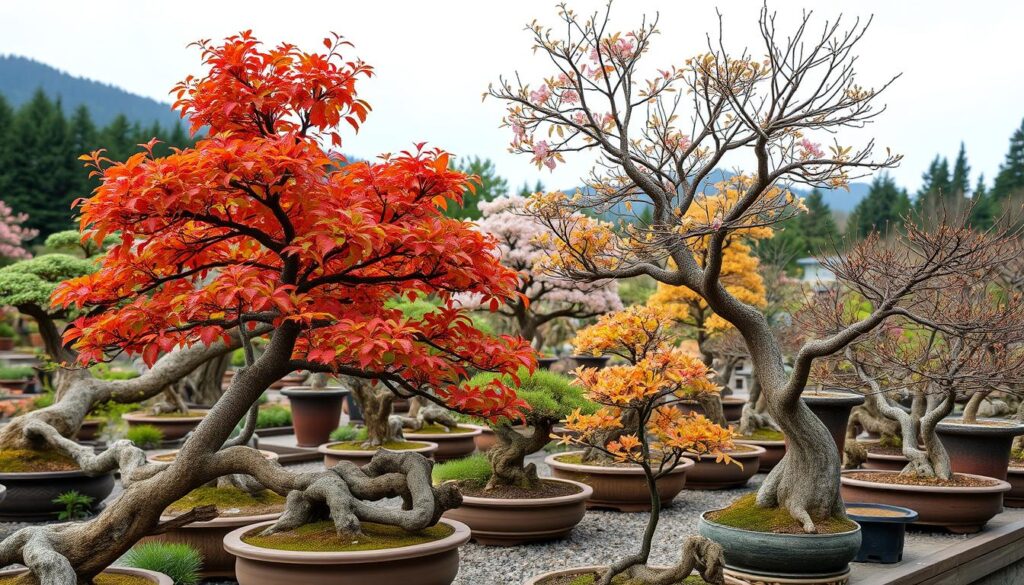
Advanced Techniques in Bonsai Identification
Learning to identify bonsai plants goes beyond just looking at leaves and trunks. Experts in bonsai identification and horticulture expertise also study flowers, fruits, and growth patterns. These details are key to understanding bonsai plants fully.
The Pseudocydonia sinensis, or Chinese quince, is a rare bonsai with unique features. Its peeling bark and large, fragrant fruit set it apart. Knowing these traits shows a deep understanding of bonsai.
Those interested in bonsai should learn about different Japanese maple and elm varieties. Looking at branch arrangements, color, and seasonal changes helps identify these trees. This knowledge is crucial for bonsai enthusiasts.
Coniferous bonsai need a close look at needle types and arrangements. Each conifer has its own special traits. Mastering these identification skills opens up the world of bonsai to enthusiasts.
“The suitability of bonsai trees to their environment is crucial to their health and growth. Research is essential to determine the best environment for bonsai, involving consultations with experienced individuals and using online resources.”
The author plans to share ten tips for bonsai beginners soon. The role of bonsai identification and horticulture expertise is vital. By exploring these advanced techniques, beginners can deepen their love and knowledge of bonsai.
Common Mistakes in Bonsai Species Recognition
Learning to identify bonsai trees is both rewarding and challenging. Many people struggle to tell apart similar species, like different maples or elms. This can cause them to care for their bonsai incorrectly, affecting its growth.
Identifying deciduous bonsai trees in winter is also tricky. Without leaves, it’s hard to tell them apart. Missing small details in bark texture or growth habits can lead to wrong identifications.
- Confusing similar bonsai species like different maple or elm varieties
- Misidentifying deciduous trees in winter without leaves
- Overlooking differences in leaf structure or bark texture
To avoid these mistakes, it’s key to develop a sharp eye for detail. Paying close attention to growth patterns, branching, and unique traits helps identify a bonsai. Knowing the scientific names and classifications of bonsai species is also vital for correct identification.
| Symptom | Potential Causes |
|---|---|
| Leaves slowly yellowing over time | Over-watering |
| Shriveling and peeling leaves and small branches | Over-watering |
| Leaves changing color, becoming brittle or falling off out of season | Under-watering |
| Brittle twigs and branches | Under-watering |
| Light and sandy soil from lack of moisture | Under-watering |
By understanding common mistakes in bonsai identification and improving their visual recognition, bonsai lovers can enhance their appreciation and care for these tiny wonders.
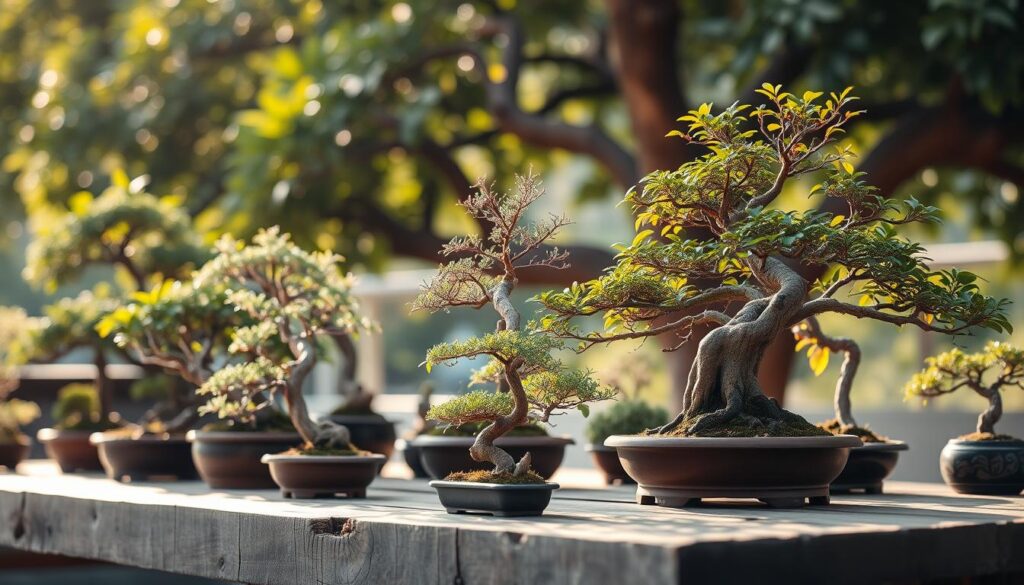
Conclusion
Learning to identify bonsai trees is a mix of science, observation, and practice. Knowing the many bonsai species is key. This includes common trees like Acer palmatum and rare ones like Adenium. It’s all about growing and loving bonsai trees.
Every bonsai tree is a world to explore. By studying their leaves, trunks, and growth, we learn more about bonsai. This knowledge makes us appreciate these tiny wonders even more.
As bonsai lovers grow, so does the need to know each tree well. This skill is vital for growing rare trees or keeping family heirlooms alive. It shows our love and commitment to this ancient art.
